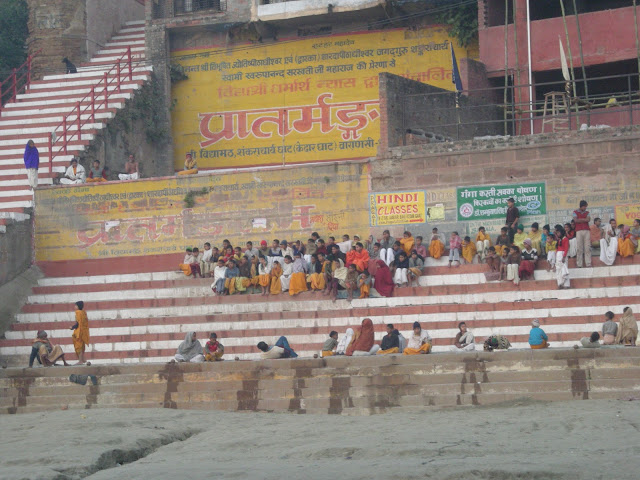December 21, 2010
Namaste;
In our first impressions, we noted that we were somewhat surprised at Delhi India India Varanasi Varanasi Ganges being to its north and that of Assi and the Ganges to its south. The third name is "Benaras", which is a Persian corruption of "Varanasi Ganges . Most important, Varanasi Jerusalem Mecca Rome
After the obligatory tour group buffet lunch, we headed into the real India
Next, we went to an archeological site (Sarnath) which is where Buddha gave his first sermon. Ironically, while Buddhism was founded in India
By this point, the sun had set and we needed to rush to our next stop--the evening service at the Ganges . This next segment is straight out of The Amazing Race. After a short bus ride back into Varanasi Calcutta India Pakistan Afghanistan Ganges . There, the nightly (yes, they do this every night) ceremony thanking the river was already underway. Thousands of people faced the river and watched as a half dozen Hindhu priests went through a 45 minute highly synchronized set of moves including throwing of flower petals, ringing bells, and waving of fire pots. All during this time there was a continual droning of holy music and burning of very smoky incense. The entire service was awe-inspiring but particularly memorable was the blowing of the conch shells which (to the 3/4 of our group that is Jewish) sounded just like the blowing of the Shofar. Indeed, several of us started chanting the prayers. With the service complete, we walked back to the square, found our rickshaw driver, rode back to the bus and then to our hotel. We got there about , had a quick dinner (guess what! Another buffet) and then right to bed as we all had mandatory wake-up calls.
Tuesday morning, we left at to see the sunrise over the Ganges . We took the bus into town (surprisingly little traffic at this hour) and walked about a mile back down to the river. This time we were put on two boats; each was a flat-bottomed craft about 8 feet abeam and 15 feet stem to stern. Our boat was rowed by one boy who looked to be about 15. We started out in total darkness (and it was also very cold - probably upper 40s), but there were still pilgrims walking on the shore and people bathing in the water. As we floated along, we were given small dishes with flower petals and a candle; our guide asked us to make our own personal prayers and then set the candles adrift in the river. It was truly inspirational. We saw the laundry women standing in the frigid water beating the clothes on the rocks. We passed a school for priests where they were chanting on the steps. At last we came to the "crematorium" on the bank of the river-- where there was a cremation in progress. About this time the orange glow of the sun began to peak over the horizon. It was an awesome moment to see something that has been going on virtually unchanged for thousands of years.
To many in our group, the poverty, deplorable living conditions, begging, and lack of sanitation were disturbing. Several voiced their thoughts: "How can they live like this", and "Aren't they miserable?". But having seen the same types of cultures and living standards in other countries, we knew it's not that simple. It is often we Westerners who are unhappy, chasing after material things, when these people may very well have everything they want or need.



